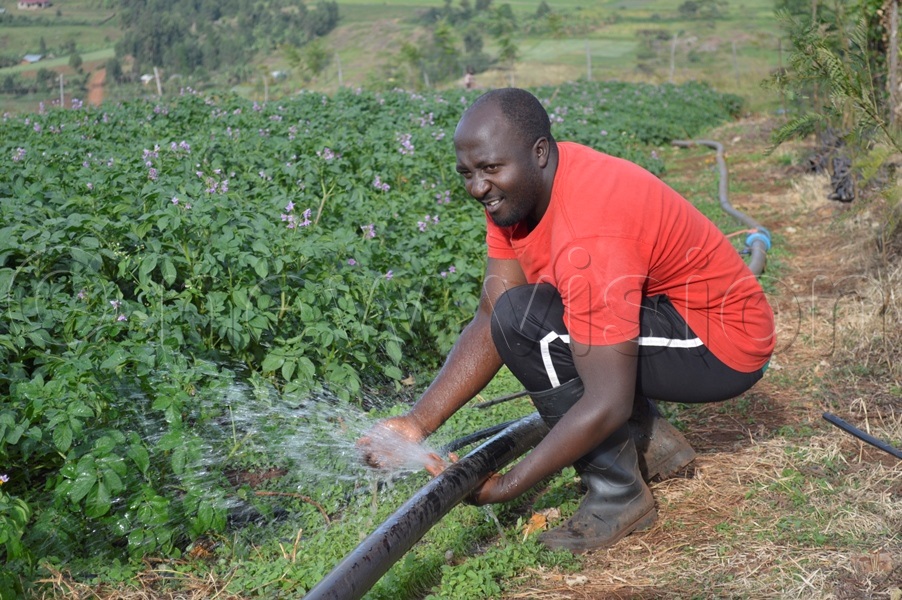By Umar Nsubuga
Twaha Kakooza’s 80-acre farm in Bubajjwe village, Kayunga district always has healthy crops even during dry spells.
He irrigates his farm.
“Many farmers are having problems due to the onset of the dry spell, but that has not affected me,” Kakooza, who grows maize, tomatoes, bananas, garlic and medicinal plants, says.
To store water for irrigation, Kakooza dug a dam on his farm. It is from this dam that water is pumped to different parts of the farm.
Kakooza uses both drip and overhead irrigation systems.
Like Kakooza, there are many irrigation systems Ugandan farmers could adopt to ensure all-year-round food production.
The commonest irrigation systems in Uganda include drip irrigation, furrow/ canal systems and sprinklers.

The system a farmer chooses depends on the size of the land and finances.
Drip irrigation
Kakooza says under drip irrigation, plants are watered using pipes with devices called emitters at a selected spacing to deliver water near the base of the plant.
The system delivers water to the area where the plant is located.
The delivery of the water can be boosted using a pump or by gravity. Water is then distributed in a farm through a plastic pipes network and is delivered to the plants through small emitters or drippers.
Rony Oved, who works with Agromax, a farm equipment company, says the drip irrigation system is good for greenhouses, vegetable gardens and even larger crops.
“We use it in banana and coffee plantations,” he says.
The cost of a drip irrigation system depends on the size of the farm. For example, a complete set that includes a water tank of about 2,000 litres and irrigation lateral lines covering half an acre costs between sh4m and sh5m.
To pump water, you can either use a motorised engine pump or a solar one. The average cost of a pump for an acre is about sh1.5m.
The system can serve for up to five years.
To avoid clogging the pipes, check the pipe joints every month by opening and closing them.
You can also have a filter at the inlet from the water source and at specific parts of the pipes to stop insoluble particles such as polythene bags from clogging the pipes.
Furrow/canal system
This is a partial surface flooding method of irrigation normally used with clean-tilled crops where water is supplied in rows. Under this system, channels are dug through the farm.
“The channels are flooded with water at least twice a week and the water gradually seeps into the soils from where it is taken up by the crops,” Aloysious Mubangizi, an irrigation consultant, says.
For this to be effective there should be a permanent water source within the vicinity — for example, a river, lake or pond. For a pond, water can be harvested off the roof of a house or from the ground running water when it rains.
“As long as there is a water source, a farmer only spends money on digging the water channels and occasionally desilting them,” Mubangizi says.
Desilting is done by removing extra soil forming on the sides/walls of the water source.
It is conducive for all types of crops. To avoid evaporation of water, farmers are advised to flood the canals either early morning or late evening when the sun is down.
Sprinkler irrigation
Kakooza says this is a planned irrigation system in which water is applied using perforated pipes or nozzles operated under pressure, to form a spray pattern above the crops.
This is good for both small and large-scale farmers. The water is sent to the pipes using either gravity or a pump.
“The main advantage is that this system replicates what rain does because it sprays water over the crops and then it trickles down,” he says.
This can be operated using both multi-stand pipes with rotating nozzles or static pipes. The main disadvantage is that it wastes water since some of it is not absorbed by the crops.
The prices start from as low as sh500,000 for a system that can be operated in a 20x20ft space.
Challenges in irrigation
John Mackay Ogwang, an expert on irrigation at Amelioration of Agricultural Risks in Mbale district, says irrigation is generally perceived to be expensive.
This has been worsened by the fact that the irrigation technologies promoted are high-tech and adopted from advanced countries.
Because of this, many farmers have been discouraged from venturing into it, limiting it to only large-scale farms.





